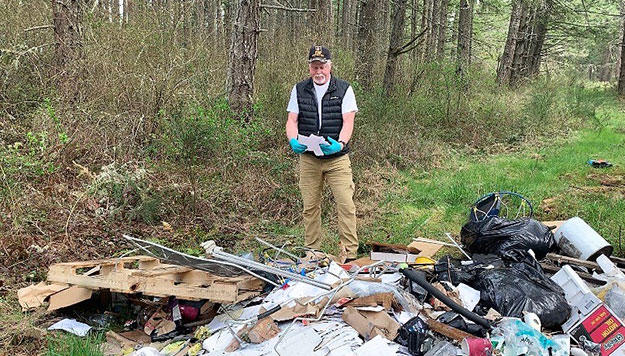With a box of latex gloves and an industrial-size bottle of hand sanitizer, "Trash Cop" Greg Mason investigates on-base dump sites as part of the Joint Base Lewis-McChord's illegal dumping program.
The program began in 2005 when it was discovered about 600 tons of trash were disposed of on JBLM each year. Due in part to Mason's efforts, that figure has decreased to about 150 tons of illegal trash each year.
Each illegal dump site can cost the base thousands of dollars in clean-up and disposal fees. Mason's job, officially an environmental investigator with JBLM's Directorate of Public Works, is to find the individuals responsible so the Office of Judicial Assistance Claims on JBLM can recoup all costs associated with the cleanup of the site.
 With 40 years of law enforcement experience, Mason uses traditional investigative procedures, such as link analysis, to process each scene or dump site. He is looking for those pieces of evidence which will connect an individual or company to the illegal dumping.
With 40 years of law enforcement experience, Mason uses traditional investigative procedures, such as link analysis, to process each scene or dump site. He is looking for those pieces of evidence which will connect an individual or company to the illegal dumping.
"What I'm looking for is some kind of receipt for just a normal purchase," Mason said. "Maybe they bought groceries, or McDonald's. Sometimes Starbucks puts labels on cups and the labels will have dates."
Mason also pays attention to environmental factors such as the amount and activity of ants and other insects to determine the date of dumping.
"If you look at the degradation of the items that have been dumped on the ground, it will roughly tell you how long it's been out here," he said. "When you leave something outside, it weathers. The rain, and the bugs, and the sun and everything else causes it to deteriorate. By looking at those things, that's one way to tell roughly how long it's been out here."
Twice a year, servicemembers pair with the JBLM environmental team to clean up the illegal dumping in training and cantonment areas.
This year's spring cleanup had Mason busy with the investigation of a large hazardous site in one of the base training areas. Among household trash were three, 55-gallon drums of used motor oil, automobile parts, an old refrigerator and bins full of financial records that led back to multiple area mechanic shops.
After collecting receipts, financial records and a shipping box complete with name and address, Mason couples that with environmental factors to determine the most likely period of dumping. When paired with information about the string of owners found readily available on the Internet, Mason is ready to bring his case against the culprit and recoup the $3,000 to $4,000 it cost JBLM to clean the site.
Since the start of the program, Mason estimates he has investigated about 15,000 illegal dump sites on base. While many times the sites consist of household garbage, a large amount of cases involve hazardous materials that can harm servicemembers, and that's why Mason is so dedicated to his job.
"The best part of my job is that I am given the latitude by my entire chain of command to help the soldiers to be safe," he said. "My heart lies with the soldiers."





Read Comments